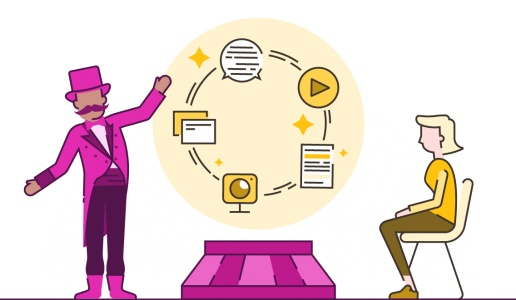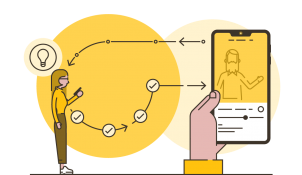Creating employee training for a large organisation can feel like playing whack-a-mole at the fair. Just when you’ve solved one need for one group, another springs up. Just when you’ve placated one stakeholder another appears out of the blue. You’re sweaty and stressed and it feels like the game will never end! Get it right and you’re rewarded with a big bag of candyfloss and the warm glow of knowing you’ve changed behaviour for the better. But getting there without help can be a real challenge.
Over the years BrightCarbon has developed training for a huge range of organisations, including large, global businesses. We’re whack-a-mole experts! So, today I’m going to share the fun of the fair by looking at some of the common challenges our clients face and exploring potential solutions.
Build online training for a hybrid work force
After a few years of disruption, lots of us are enjoying being back in the office more regularly. Despite this around 70% of firms have plans to implement hybrid working arrangements, with employees splitting their time between their home office and the workplace. This will be welcome as flexible work opportunities are a deciding factor for 80% of employees when they’re assessing job offers.
What this boils down to for L&D leaders is that hauling everyone into a classroom for face-to-face training is much more difficult than it used to be and can lead to resentment. Fortunately, though not all face-to-face training can be replaced by online training, a lot of it can. Moving training online makes it much easier and quicker to disseminate information across an organization.
The downside to an online employee training program is that learners can feel more isolated. To increase learners’ engagement think about creating a learning experience – not just an online course or instructor-led session. This experience could include:
- A mentor/buddy system – To ensure people feel invested in and supported through the learning process.
- Social learning – Using message boards or group chats where learners can discuss the content (or vie with each other for the top spot on the leaderboard!)
- Asynchronous training – Adding flexibility in when training takes place means it is less disruptive
- Robust follow up – Follow up is really important. We forget most of what we learn, pretty soon after we learn it so one 20 minute module is unlikely to have a huge impact on your learners. However, if you follow that up with a series of microlearnings to top up your learners’ knowledge, plus on the job help, you’ll be getting somewhere.
We’ve written more about running successful virtual instructor led trainings, including post-session materials here: How to run Virtual Instructor-Led Training.
Employee training for an international workforce
Asynchronous online training lets you reach your entire employee population with the same piece of training regardless of time zones. But when you’re creating an employee training program for a large organization, translation and localisation are likely to be needed. We’ve already written about some of the difficulties of and solutions for eLearning translation and you can read about that here: eLearning translation challenges and how to overcome them
It’s also worth thinking about whether you’ll need to provide different resources for different geographies (does everyone use the same software? Are processes impacted by different rules and regulations?) Build this into your timeline from the beginning so it’s not a nasty shock later on!
Supporting your diverse workforce
Reflecting diverse backgrounds
An employer’s attitude towards championing diversity is a key factor for many in the workforce and D&I is already on most L&D leaders priority list. Your company values should be as apparent in your employee training as on your website or recruitment materials. This is a substantial topic, and we talk about it a little more in this article: Online training for the TikTok generation. In the meantime, here are a few key considerations:
- To avoid ‘check box’ diversity, focus on both showing a diverse range of people (age, race, disabilities, gender, body type etc.), and telling a diverse range of stories.
- When getting voiceover recorded, consider moving away from the bland, corporate standard. Think about whether a range of regional and/or international accents would better reflect your workforce.
- Use language appropriately – you’re responsible for using inclusive language and avoiding ableist, sexist, racist or otherwise exclusionary or offensive language.
- Remember that diversity looks different in different places – how can you make sure your global workforce sees themselves in your training programs?
Meeting diverse access needs
Accessible employee training is not only expected by employees but, depending where your organisation is based, it’s often a legal obligation. It’s important to consider accessibility as early as possible and at every stage of development as it’s much more difficult and expensive to retrofit accessibility after design has been completed.
Here are a few things to consider:
- Screen reader accessibility
- Closed captioning on videos and other audio
- Accessibility of interactions
- Colour contrast
- Font readability
You should also think about providing different ways for people to learn. You don’t have to provide a one-size-fit all people development solution and can make different options available (such as transcripts, captioned videos, PDF read throughs) without too much extra effort.
Learn more about creating accessible eLearning here.
Acknowledging diverse prior knowledge
If you’re creating an employee training program for a large organisation, it’s highly likely that your learners will have different levels of entry. Some may be practically subject matter experts, some may have never heard of the topic before. Forcing people to sit through hours of content when they already know the answers could lead to frustrated, disengaged employees.
One great option is to create bespoke training with the option to test out at different points so employees who can meet the learning objectives already can skip ahead to the assessment or to more relevant topics. You can also create branching training which could show the learner different content depending on their job role, tenure, or training they’ve already completed.
Anticipate organisational complexity
When you’re creating training for large organisations you’re almost always juggling three to five stakeholders too many! Work out who you need buy in from before you start developing content and decide who needs to sign off on what when (learning objectives, scripts, storyboards, design etc.). It’s also important to have clearly defined roles within your team. Having all this agreed upfront will help prevent roadblocks later on.
Always test out your files on your LMS in advance of your launch date (and let your LMS manager know that it’s coming!) so you can iron out any final technical glitches. If you need legal sign off make sure to bake this into your timeline too, as well as time to make any changes based on their feedback.
In fact, it’s probably fair to say that the more people that are involved, the more complicated and lengthy the process is likely to be. So, make sure you have a good project manager keeping track of timelines, reviews and deliverables and build in plenty of buffer time,
If you’re looking for a partner on your next employee training program, get in touch!
Leave a comment




